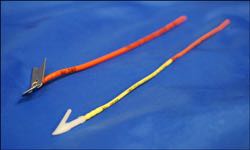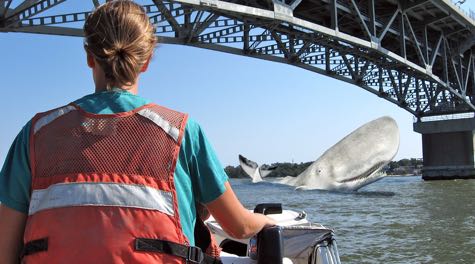VIMS researchers spot albino whale in York River
Researchers with the Virginia Institute of Marine Science today reported the sighting of a rare albino sperm whale in the shallows of the York River, the first glimpse of any whale in local waters since a dead humpback washed ashore on a Goodwin Island sandbar in 2009.
VIMS Captain Herman Baha and crewmembers aboard VIMS’ newest research vessel Pequod spotted the lengthy leviathan while returning to the institute’s Gloucester Point campus following nighttime deployment of a high-tech buoy to monitor acoustically tagged sturgeon.
Baha waxed poetic in describing the unusual creature, saying “we had just embarked from Yorktown after a morning coffee at Starbucks, and were gliding through these latte waters, when a silvery jet was seen far in advance of the white bubbles at the bow. Lit up by the moon, it looked celestial; seemed some plumed and glittering god uprising from the sea.”
Marine safety officer Jim Goins, aboard the Pequod to follow up on grad-student complaints concerning Captain Baha’s recent obsessive behavior, says “I watched the Captain closely, and can report that he's a grand, ungodly, god-like man who nevertheless has his humanities. I just had to remind him of the Marine Mammal Protection Act."
Goins, marine superintendent Durand Ward, and grad students Sarah Peleg and Ishmael Irby confirm the Captain’s sighting of the colossal cetacean. “We all saw the pale form of the heaving leviathan,” reports Peleg, who is ironically studying white perch for her Master’s thesis. “I estimate he reached near half a furlong.’
Irby, a member of VIMS’ Multispecies Monitoring and Assessment Program, says the experience ranks as a highlight of his academic career. “Whenever it is a damp, drizzly November in my soul, whenever it requires a strong moral principle to prevent me from deliberately stepping into Greate Road, and methodically knocking people's hats off—then, I account it high time to get to sea as soon as I can. This was the reward for one of those decisions. To and fro in the deeps, far down in the bottomless blue, rushed mighty leviathans, sword-fish, and sharks.”
 After the sighting, the VIMS scientists were able to use a harpoon tag to emplace a satellite transmitter into the cetacean’s deep blubber. The tag will allow them to track the creature’s future movements. Baha subsequently urged his crewmates to pursue the now angry whale further upstream, but because state and federal regulations prohibit the harassment of any marine mammal, Goins quickly took the helm and returned the Pequod to the VIMS Boat Basin.
After the sighting, the VIMS scientists were able to use a harpoon tag to emplace a satellite transmitter into the cetacean’s deep blubber. The tag will allow them to track the creature’s future movements. Baha subsequently urged his crewmates to pursue the now angry whale further upstream, but because state and federal regulations prohibit the harassment of any marine mammal, Goins quickly took the helm and returned the Pequod to the VIMS Boat Basin.
Numerous sources report, however, that Baha was later seen leaving Gloucester Point in a small privateer. “He told me he would take the whale head-and-head,” says Goins. “That is, pull straight up to his forehead—a not uncommon thing; for when within a certain limit, such a course excludes the coming onset from the whale's sidelong vision.”
Commuters on the Coleman Bridge later reported a remarkable sight as Baha battled the whale from the stern of his skiff. VIMS professor Deborah Steinberg, who crosses the bridge daily from Williamsburg, says “Ere that close limit was gained, and while the boat was still plain to my eye; the White Whale churning himself into furious speed, almost in an instant as it were, rushing among the boats with open jaws, and a lashing tail, offered appalling battle on every side; and heedless of the irons darted at him, seemed only intent on annihilating each separate plank of which the skiff was made.”
U.S. Coast Guard rescue boats are now on the scene, so stay tuned for further updates.



